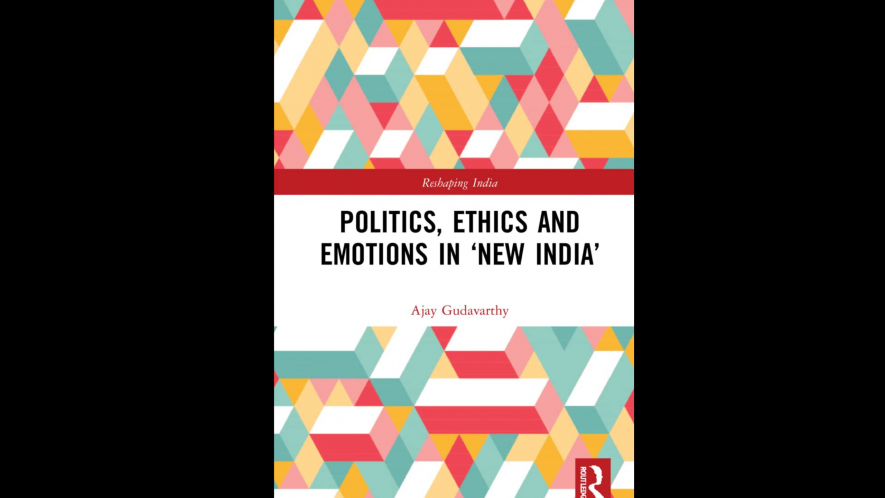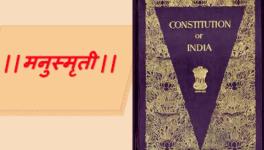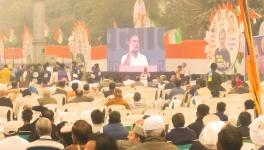Remedy for India’s Hindutva Haze

Politics, Ethics and Emotions in ‘New India’(cover page of book). Image Courtesy: Amazon.in
In Politics, Ethics and Emotions in ‘New India’ (Routledge, 2023), Ajay Gudavarthy takes a worm’s eye view of Indian politics. Instead of using a macro-sociological or historical framework, he couches his understanding in the micro-category of ‘emotions.’ His chief thesis is that if the twentieth century was the Age of Revolutions a la Eric Hobsbawm, the twenty-first century is the ‘Age of Emotions’. There is a two-fold reason for this: Firstly, it is not a rationalist balance sheet of success or failures in delivering public goods but the intensely emotional appeal of its vile ideological agenda that has come to have a cross-class/caste acceptance that explains the Hindutva-corporate regime’s continuance.
Gudavarthy recounts a conversation during his daily nocturnal visits to his regular paan-wala. The latter was unhappy at his insistence that despite Modi’s lofty promises, India remains poor and retorted, ‘Who says India is poor? This is just meaningless talk by educated people like you. These days, even a beggar takes home a thousand rupees a day. Please don’t talk ill about the country.’ A carpenter confided that despite the price rise, ‘I will vote for Modi, he is a dangerous man, he can do anything’. The answer was puzzling. A taxi driver in Bangalore showed him a photo on his mobile wherein Congress leader Rahul Gandhi was wearing a skullcap and surrounded by three burqa-clad women. He said of Gandhi, ‘This man is immoral. How can he marry three women?’ The encounter with a Buddhist driver in Dharmshala was worse. He said, ‘I never allow a Muslim passenger to sit in the back seat…don’t know when he would slit my throat’.
Cumulatively, the source of such indignation among the under-classes is a micro-emotional manifestation of Hindutva’s crudity, which was earlier the preserve of the upper-class/caste elites. The latter often used to have weird household generalisations about the housemaid practising witchcraft, of the male help being a congenital thief, Muslims carrying a peculiar bodily odour, the non-elite castes having a violent disposition, and so on. All this has been substituted by “the Muslim”, who seems to carry the odium of all human vices. Opposition parties who claim to stand by his side are at the receiving end of opprobrium as well. What has led to this situation?
Gudavarthy thinks that ‘narratives such as these look random, happenstance, illogical, and ill-informed…what underlies these popular perceptions that become the basis for the emergent emotive majority is their emotional content. They absorb emotions that lie subsumed by a liberal order.’
The Narendra Modi phenomenon is the ability to connect to ‘latent emotions and everyday ethics’. The packaging of Brand Modi has another crucial add-on that all his other political opponents lack: trust. It is based on the ‘adulation of ethics of sacrifice, selflessness, compassion, and a commitment towards larger good’. Compare this to Gandhi. He is a bachelor. His Bharat Jodo yatra was indeed heroic. Yet he has not been able to create a halo around himself, although it was never consciously attempted.
The case for Modi has been in the making for the past two decades or more. Although artificial, the trust he garners, whether through theatrics as a monk, mother-worshipping son, religious Hindu prostrating at temples, etc., rarely works for others. Those attempting the same are either considered to be interlopers or failed mimics. They fail to evoke ‘trust’ among the people. The mantle of trust with Modi is so strong that even when he undoes all his frugal saintliness by wearing super-expensive sunglasses and suits, his voters and supporters qualify his exuberance as ‘well-deserved’. With others, it is the opposite. One only needs to remember the bogus narrative about Gandhi’s t-shirt, which many lapped up.
People’s general ‘non-critical’ attitude is another crucial element to the persistent dilemma. Gudavarthy argues that ‘fear is silently playing its role…it can lead to a degree of self-censorship where even the obvious begins to create doubt if one is reading the situation correctly or missing the point. In everyday conversations, people generally were confident, bordering on self-righteousness, but today they sound tenuous, unsure, and, therefore, not prepared to critique the government’. The diagnosis seems to hit the nail on its head. During the protests against the UPA II regime and Anna Hazare’s melodramatic soap opera, criticism of the government was always forthcoming and ‘desirable’. The middle classes then hit the streets, almost ‘fearlessly’ against black money and corruption. Now, despite the Rafale scam, a botched demonetisation policy, and the Adani scandal, the streets are empty.
Gudavarthy offers a two-fold prescription for coming out of the current miasma. Firstly, he argues that India needs a solid dose of ‘positive emotions of love, compassion, and care’. He does not define love as such but means it in contradistinction to hate, which is being pedalled by the Sangh Parivar and its constituents.
Hundreds of instances of inter-communal harmony that exist both in the contemporary and history of India can represent it. A formidable political project of integrating such narratives must be sewn into the program of all the opposition parties so that it counters the unified, monolithic, and vicious Hindutva narrative. Secondly, the promise of a genuine welfare state which could sustain ‘compassion and love not as an abstract ideal but as an everyday ethic’.
The book is a must-read for those who still have compassion left in the closet of their emotions and are willing to take it out for the purpose of ‘politics’.
The author is a lawyer practising in Delhi. The views are personal.
Get the latest reports & analysis with people's perspective on Protests, movements & deep analytical videos, discussions of the current affairs in your Telegram app. Subscribe to NewsClick's Telegram channel & get Real-Time updates on stories, as they get published on our website.





















